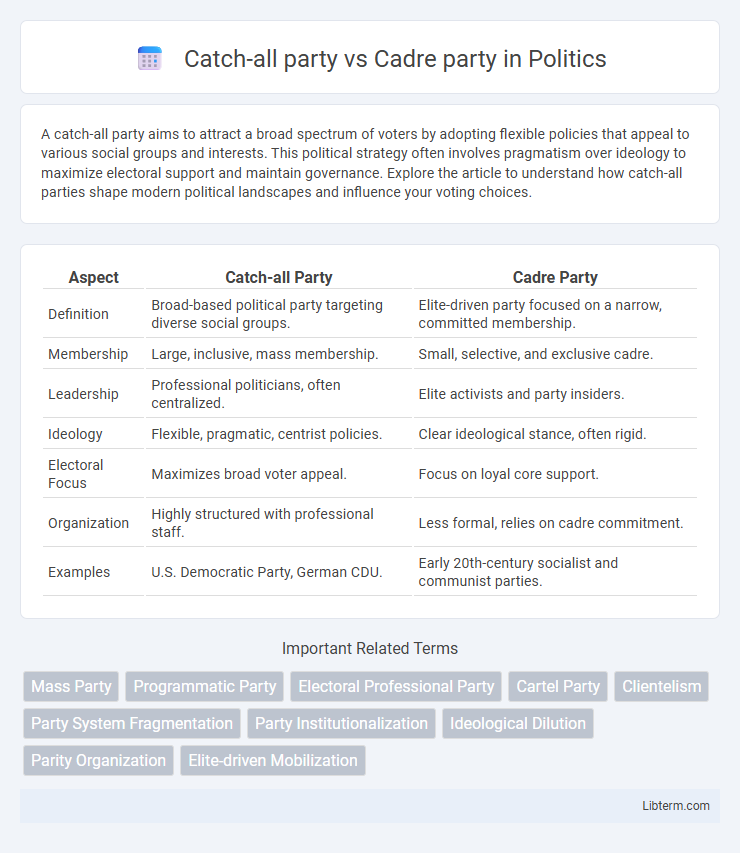A catch-all party aims to attract a broad spectrum of voters by adopting flexible policies that appeal to various social groups and interests. This political strategy often involves pragmatism over ideology to maximize electoral support and maintain governance. Explore the article to understand how catch-all parties shape modern political landscapes and influence your voting choices.
Table of Comparison
| Aspect | Catch-all Party | Cadre Party |
|---|---|---|
| Definition | Broad-based political party targeting diverse social groups. | Elite-driven party focused on a narrow, committed membership. |
| Membership | Large, inclusive, mass membership. | Small, selective, and exclusive cadre. |
| Leadership | Professional politicians, often centralized. | Elite activists and party insiders. |
| Ideology | Flexible, pragmatic, centrist policies. | Clear ideological stance, often rigid. |
| Electoral Focus | Maximizes broad voter appeal. | Focus on loyal core support. |
| Organization | Highly structured with professional staff. | Less formal, relies on cadre commitment. |
| Examples | U.S. Democratic Party, German CDU. | Early 20th-century socialist and communist parties. |
Introduction to Catch-All and Cadre Parties
Catch-all parties aim to attract a broad spectrum of voters by downplaying ideology and emphasizing pragmatic policies, often relying on mass media and professional campaigning. Cadre parties, in contrast, depend on a small, organized group of elites and activists who control party decisions and maintain strict ideological coherence. The distinction highlights variations in party structure, voter base, and political strategy across different electoral systems.
Historical Background of Party Types
Catch-all parties emerged in the early 20th century as mass-oriented political organizations designed to appeal to a broad spectrum of voters, transcending traditional class or ideological divisions. Cadre parties, by contrast, originated in the 19th century as elite-based groups with limited, highly active memberships focused on maintaining political control within established hierarchies. The historical shift from cadre to catch-all parties reflects changes in democratic participation, mass enfranchisement, and the need for broader electoral coalitions.
Defining Catch-All Parties
Catch-all parties prioritize broad voter appeal by minimizing ideological constraints and incorporating diverse policy positions to attract a wide electorate. These parties often emphasize pragmatic governance, reducing emphasis on class-based or traditional group loyalties to maximize votes across social strata. In contrast, cadre parties are typically elite-driven, focusing on a smaller, committed membership base with clear policy goals and hierarchical organization.
Characteristics of Cadre Parties
Cadre parties are characterized by their elite-driven structure, where leadership is composed primarily of a small group of professional politicians or influential figures rather than mass membership. These parties emphasize organizational discipline, centralized decision-making, and often cater to specific interest groups or bureaucratic elites. Unlike catch-all parties, cadre parties rely less on broad electoral appeals and more on internal cohesion and elite support to maintain political power.
Organizational Structures Compared
Catch-all parties maintain flexible organizational structures prioritizing broad voter appeal and decentralized decision-making to accommodate diverse interests. Cadre parties emphasize a centralized, hierarchical framework with a professionalized membership focused on elite political participation and efficient policy execution. The distinction reflects catch-all parties' adaptability contrasted with cadre parties' structured, top-down control.
Electoral Strategies and Voter Appeal
Catch-all parties employ broad electoral strategies that target diverse voter groups across multiple demographics, maximizing appeal through inclusive policy platforms and pragmatic campaigning. Cadre parties focus on mobilizing a selective, organized elite base, emphasizing ideological coherence and strong leadership to secure committed votes rather than mass appeal. Catch-all parties adapt easily to changing electoral landscapes, while cadre parties rely on loyal networks to maintain political influence.
Influence on Political Systems
Catch-all parties shape political systems by broadening electoral appeal, integrating diverse social groups, and promoting centrist policies to maintain mass support and governability. Cadre parties influence political systems through elite networks, emphasizing party organization and discipline, which centralizes power and often limits mass participation. The distinct strategies of catch-all and cadre parties affect democratic representation, party competition, and policy-making processes within various political systems.
Strengths and Weaknesses of Each Model
Catch-all parties excel at appealing to a broad electorate by embracing diverse policy positions, increasing their chances of electoral success and governance stability. However, their ideological flexibility can lead to internal conflicts and voter distrust due to perceived lack of clear principles. Cadre parties benefit from strong organizational discipline and ideological coherence, fostering loyalty among core supporters, but often struggle to expand beyond elite bases and adapt to mass electoral demands.
Global Examples and Case Studies
Catch-all parties, exemplified by Germany's CDU and the US Democratic Party, broaden their appeal by targeting diverse voter groups across socioeconomic and ideological lines, adapting policies to capture a wide electorate. Cadre parties, such as the historical British Conservative Party and early 20th-century Italian Fascists, rely on a dedicated core of elite members and emphasize disciplined organization over mass appeal. Case studies reveal catch-all parties thrive in pluralistic democracies by promoting inclusiveness, while cadre parties often dominate in more centralized political systems or authoritarian contexts where leadership control is paramount.
Future Trends in Political Party Evolution
Catch-all parties increasingly adopt digital technologies and data analytics to engage diverse voter bases, reflecting a shift toward more personalized political communication. Cadre parties emphasize specialized expertise and network building within political elites, adapting to future trends by fostering professionalization and institutional stability. Political party evolution will likely see hybrid models combining catch-all inclusiveness with cadre party organizational sophistication to address complex governance challenges.
Catch-all party Infographic

 libterm.com
libterm.com